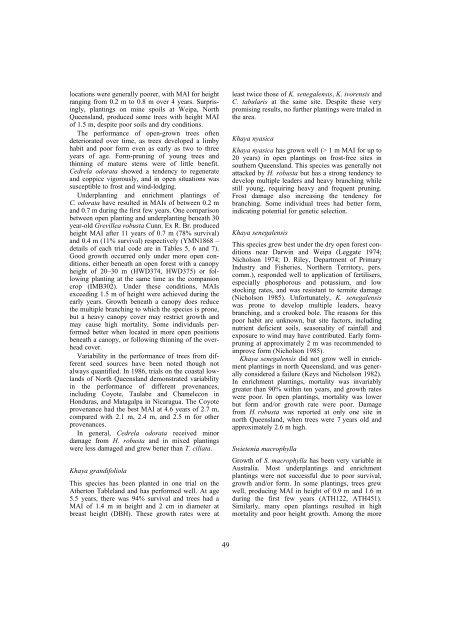Hypsipyla Shoot Borers of Meliaceae in Sri Lanka - Australian ...
Hypsipyla Shoot Borers of Meliaceae in Sri Lanka - Australian ...
Hypsipyla Shoot Borers of Meliaceae in Sri Lanka - Australian ...
Create successful ePaper yourself
Turn your PDF publications into a flip-book with our unique Google optimized e-Paper software.
locations were generally poorer, with MAI for height<br />
rang<strong>in</strong>g from 0.2 m to 0.8 m over 4 years. Surpris<strong>in</strong>gly,<br />
plant<strong>in</strong>gs on m<strong>in</strong>e spoils at Weipa, North<br />
Queensland, produced some trees with height MAI<br />
<strong>of</strong> 1.5 m, despite poor soils and dry conditions.<br />
The performance <strong>of</strong> open-grown trees <strong>of</strong>ten<br />
deteriorated over time, as trees developed a limby<br />
habit and poor form even as early as two to three<br />
years <strong>of</strong> age. Form-prun<strong>in</strong>g <strong>of</strong> young trees and<br />
th<strong>in</strong>n<strong>in</strong>g <strong>of</strong> mature stems were <strong>of</strong> little benefit.<br />
Cedrela odorata showed a tendency to regenerate<br />
and coppice vigorously, and <strong>in</strong> open situations was<br />
susceptible to frost and w<strong>in</strong>d-lodg<strong>in</strong>g.<br />
Underplant<strong>in</strong>g and enrichment plant<strong>in</strong>gs <strong>of</strong><br />
C. odorata have resulted <strong>in</strong> MAIs <strong>of</strong> between 0.2 m<br />
and 0.7 m dur<strong>in</strong>g the first few years. One comparison<br />
between open plant<strong>in</strong>g and underplant<strong>in</strong>g beneath 30<br />
year-old Grevillea robusta Cunn. Ex R. Br. produced<br />
height MAI after 11 years <strong>of</strong> 0.7 m (78% survival)<br />
and 0.4 m (11% survival) respectively (YMN1868 –<br />
details <strong>of</strong> each trial code are <strong>in</strong> Tables 5, 6 and 7).<br />
Good growth occurred only under more open conditions,<br />
either beneath an open forest with a canopy<br />
height <strong>of</strong> 20–30 m (HWD374, HWD375) or follow<strong>in</strong>g<br />
plant<strong>in</strong>g at the same time as the companion<br />
crop (IMB302). Under these conditions, MAIs<br />
exceed<strong>in</strong>g 1.5 m <strong>of</strong> height were achieved dur<strong>in</strong>g the<br />
early years. Growth beneath a canopy does reduce<br />
the multiple branch<strong>in</strong>g to which the species is prone,<br />
but a heavy canopy cover may restrict growth and<br />
may cause high mortality. Some <strong>in</strong>dividuals performed<br />
better when located <strong>in</strong> more open positions<br />
beneath a canopy, or follow<strong>in</strong>g th<strong>in</strong>n<strong>in</strong>g <strong>of</strong> the overhead<br />
cover.<br />
Variability <strong>in</strong> the performance <strong>of</strong> trees from different<br />
seed sources have been noted though not<br />
always quantified. In 1986, trials on the coastal lowlands<br />
<strong>of</strong> North Queensland demonstrated variability<br />
<strong>in</strong> the performance <strong>of</strong> different provenances,<br />
<strong>in</strong>clud<strong>in</strong>g Coyote, Taulabe and Chamelecon <strong>in</strong><br />
Honduras, and Matagalpa <strong>in</strong> Nicaragua. The Coyote<br />
provenance had the best MAI at 4.6 years <strong>of</strong> 2.7 m,<br />
compared with 2.1 m, 2.4 m, and 2.5 m for other<br />
provenances.<br />
In general, Cedrela odorata received m<strong>in</strong>or<br />
damage from H. robusta and <strong>in</strong> mixed plant<strong>in</strong>gs<br />
were less damaged and grew better than T. ciliata.<br />
Khaya grandifoliola<br />
This species has been planted <strong>in</strong> one trial on the<br />
Atherton Tableland and has performed well. At age<br />
5.5 years, there was 94% survival and trees had a<br />
MAI <strong>of</strong> 1.4 m <strong>in</strong> height and 2 cm <strong>in</strong> diameter at<br />
breast height (DBH). These growth rates were at<br />
49<br />
least twice those <strong>of</strong> K. senegalensis, K. ivorensis and<br />
C. tabularis at the same site. Despite these very<br />
promis<strong>in</strong>g results, no further plant<strong>in</strong>gs were trialed <strong>in</strong><br />
the area.<br />
Khaya nyasica<br />
Khaya nyasica has grown well (> 1 m MAI for up to<br />
20 years) <strong>in</strong> open plant<strong>in</strong>gs on frost-free sites <strong>in</strong><br />
southern Queensland. This species was generally not<br />
attacked by H. robusta but has a strong tendency to<br />
develop multiple leaders and heavy branch<strong>in</strong>g while<br />
still young, requir<strong>in</strong>g heavy and frequent prun<strong>in</strong>g.<br />
Frost damage also <strong>in</strong>creas<strong>in</strong>g the tendency for<br />
branch<strong>in</strong>g. Some <strong>in</strong>dividual trees had better form,<br />
<strong>in</strong>dicat<strong>in</strong>g potential for genetic selection.<br />
Khaya senegalensis<br />
This species grew best under the dry open forest conditions<br />
near Darw<strong>in</strong> and Weipa (Leggate 1974;<br />
Nicholson 1974; D. Riley, Department <strong>of</strong> Primary<br />
Industry and Fisheries, Northern Territory, pers.<br />
comm.), responded well to application <strong>of</strong> fertilisers,<br />
especially phosphorous and potassium, and low<br />
stock<strong>in</strong>g rates, and was resistant to termite damage<br />
(Nicholson 1985). Unfortunately, K. senegalensis<br />
was prone to develop multiple leaders, heavy<br />
branch<strong>in</strong>g, and a crooked bole. The reasons for this<br />
poor habit are unknown, but site factors, <strong>in</strong>clud<strong>in</strong>g<br />
nutrient deficient soils, seasonality <strong>of</strong> ra<strong>in</strong>fall and<br />
exposure to w<strong>in</strong>d may have contributed. Early formprun<strong>in</strong>g<br />
at approximately 2 m was recommended to<br />
improve form (Nicholson 1985).<br />
Khaya senegalensis did not grow well <strong>in</strong> enrichment<br />
plant<strong>in</strong>gs <strong>in</strong> north Queensland, and was generally<br />
considered a failure (Keys and Nicholson 1982).<br />
In enrichment plant<strong>in</strong>gs, mortality was <strong>in</strong>variably<br />
greater than 90% with<strong>in</strong> ten years, and growth rates<br />
were poor. In open plant<strong>in</strong>gs, mortality was lower<br />
but form and/or growth rate were poor. Damage<br />
from H. robusta was reported at only one site <strong>in</strong><br />
north Queensland, when trees were 7 years old and<br />
approximately 2.6 m high.<br />
Swietenia macrophylla<br />
Growth <strong>of</strong> S. macrophylla has been very variable <strong>in</strong><br />
Australia. Most underplant<strong>in</strong>gs and enrichment<br />
plant<strong>in</strong>gs were not successful due to poor survival,<br />
growth and/or form. In some plant<strong>in</strong>gs, trees grew<br />
well, produc<strong>in</strong>g MAI <strong>in</strong> height <strong>of</strong> 0.9 m and 1.6 m<br />
dur<strong>in</strong>g the first few years (ATH122, ATH451).<br />
Similarly, many open plant<strong>in</strong>gs resulted <strong>in</strong> high<br />
mortality and poor height growth. Among the more

















